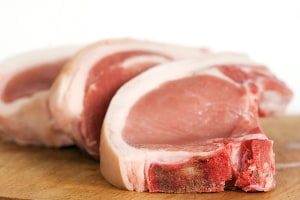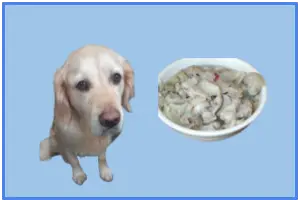
Raw pork is dangerous to dogs. This is because it contains harmful bacteria which can cause your dog to become ill, as well as a high-fat content that may cause your dog to have digestion issues.
If your dog has eaten large quantities of raw pork, it’s best to ring your vet to see what advice they can offer.
In most cases, they will ask you to keep an eye on your pet for any signs of discomfort or illness and only then bring them into the clinic.
If your dog shows no sign of illness, then it probably only ate a small amount of pork and there is little need to worry.
However, always watch out for symptoms of stomach issues for a few days after consumption.
Before you give your dog any new types of food, it’s always best to check if they are dog-friendly to save your pooch any upset.
This can be done through a simple google search so there is little excuse to giving your dog something that could poison it or cause it to become unwell.
What Are The Dangers Of Dogs Eating Raw Pork?
Pork like any raw meat may contain a number of harmful bacteria.
Although pork has a variety of health benefits such as being high in protein and minerals, when eaten raw, this meat is particularly well-known for harbouring parasites such as tapeworms.
Therefore, its generally recommended that both humans and animals only eat pork when it is cooked.
What Are The Potential Side Effects Of Your Dog Eating Contaminated Raw Pork?
Feeding your dog uncooked pork can be dangerous for its health.
This is because it often contains a parasite called trichinella spiralis larvae inside it which can cause infections such as trichinosis.
Symptoms of this in dogs can include vomiting, diarrhoea, fever, tiredness, stiffness, and pain, especially around the stomach.
Although your dog is extremely unlikely to die from this illness, it will make your dog very unwell. So, to prevent them from becoming ill in the first place, it’s best to steer clear from feeding your pooch raw pork.
Should You Phone The Vet Or Is There Something You Can Do At Home?
If your dog has only eaten a small amount of raw pork, then it will most likely be fine.
Even if your canine has eaten a large amount, you should only go to the vet if your dog is showing symptoms of an infection.
This will help to keep your vet bills low and not waste your veterinarian’s time.
Instead, the first point of action could be to ring your vets and follow their advice based on the specific circumstances of how much pork your dog has eaten.
Their suggestions will vary depending on the severity of your canines’ symptoms (if they are showing any).
Often, they will merely suggest keeping an eye on your dog to check for any developing signs of infection.
How Might Pork Fat Make Your Dog Ill?
Another issue with dogs eating pork is that this meat has high quantities of fat.
This is very difficult for dogs to digest and can lead to several health issues like indigestion, gastrointestinal issues, or in worst cases pancreatitis.
Instead, there are a number of healthy fats that your dog can enjoy such as fish oils added to their regular food which will help them maintain a balanced diet and keep their coat in a good condition. Foods like eggs, nut butter, and avocados can be added as healthy fats to their diets too.
This will spare them the stomach issues and still give them the treats they deserve.
What Are The Dangers Of Your Dog Eating Pork Bone?
Vets often suggest giving dogs raw bones after they have eaten as they have many health benefits, especially in removing plaque build-up from their teeth.
But, these should never be pork or poultry bones!
This is because pork and poultry bones are more likely to shatter or splinter when your dog chews on them.
So, they are serious choking hazards, can lead to intestinal blockages, and can cause cuts to the mouth or throat which can require your dog to need surgery or even die.
If you do give your dog a bone, you should only give them it for a few minutes before removing it and it’s best to supervise your dog while they chew on it.
Is There Any Meat Which Is Safe For Your Dog To Eat Raw?
Cooking meat makes it more digestible for your dog.
However, dogs can in fact eat some raw meats without getting ill, although it is generally not recommended by vets.
Consuming too much raw meat in an unbalanced diet may lead to nutritional problems or deficiencies.
Therefore, if you are giving your dog raw meat it should only be in small quantities, if at all.
Instead, try dog-safe raw vegetables and fruit such as apples, carrots, and bananas.
These should only be given as treats and not as a sole diet, but they can be incorporated into homemade dog foods which will help to give your dog a variety of nutrients.
What Is The Nutrition In Pork (Chop)?
Nutritionally, pork chops contain around 211 calories per serving. One serving comprises of 11 grams of fat, 84mg of cholesterol, 514mg of sodium, 0 grams of carbohydrates, and over 28g of protein.
This makes this meat around 97% protein and very low carb.
Although this meat is around 61% fat, it is clearly a very nutritious treat as part of a balanced and healthy lifestyle.
Eating this meat will help to build muscle and keep your dog lean, but if eaten too often will contribute to the production of fat.
What Is The Safest Way To Prepare Pork For Your Dog?
The safest way to prepare pork for your dog is to chop it into small, bite-size pieces and bake it in a lightly sprayed pan for around 20 minutes in the oven.
This should only be done with lean cuts of pork.
Cutting off the majority of the fats will also help your dog to digest the pork more easily and prevent them from having stomach issues down the line.
You can also make homemade dog food with pork by baking it with a variety of dog-safe vegetables, hard-boiled eggs, brown rice, and mixing together.
Your dog will love this and your efforts will definitely be appreciated! Although vets often recommend specialised dog food brands, it is also important to mix up their diet and allow them to try other foods.
Pork vs Chicken. Which Has Better Nutrition?
In comparison, chicken has only around 134 calories per serving.
It contains 7.7g of fat, 39mg of cholesterol, 883mg of sodium, 1.8g of carbohydrates, and 15g of protein. This makes a serving of chicken around 84% protein and 55% fat.
This technically makes chicken a ‘healthier’ option, however, lean cuts of pork have much lower fat contents than recorded above.
Although people trying to keep their dogs healthy generally opt for chicken as a treat because it is a source of protein and nutrition, pork can also be beneficial depending on which type of pork you are feeding your dog.
For instance, sausages made from factory-farmed pigs are full of saturated fat and harmful chemicals, whereas a pastured pork leg may be highly beneficial for your dog to bulk up and build some muscle due to its higher protein content than chicken.
What Is The Most Dangerous Raw Meat And Why?
Chicken is the most popular meat on the market.
However, it is often associated with salmonella. So, its recommended to never give your dog raw chicken.
Although salmonellosis in dogs is rare, they can be carriers of the bacteria which they can then spread throughout their households from their stool and saliva.
Hospitalizations caused by salmonella put chicken in the highest risk category of meat and this infection kills many people across the US every year.
So, if you’ve fed your dog raw chicken it’s important to be aware of this before you kiss them, touch their stool when cleaning up, or let them salivate on you.
Symptoms of salmonella in dogs include diarrhoea, tiredness, stomach cramps, loss of appetite, and a fever.
Most animals can recover without antibiotics however in severe cases they may be necessary and a visit to the clinic may be advised.
E.coli and Campylobacter outbreaks are also associated with chickens.
As well as this, eating factory-produced chicken has been known to cause antibiotic-resistant bacterial infections.
These chickens are given antibiotics, steroids, hormones, exposed to additives, pesticides, and kept in extremely cramped conditions which are bad for their overall health.
So, eating chicken produced this way means that our furry friends are consuming everything that the chicken has been exposed to and increases their risks of catching illnesses.
All of this combined makes chicken the most dangerous meat for dogs to eat.






